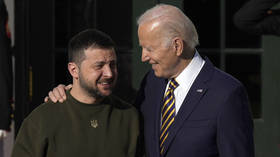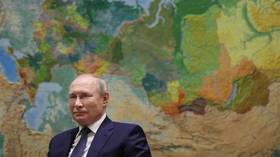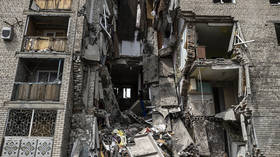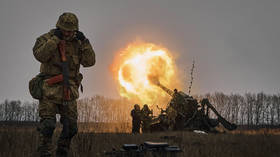Andrey Sushentsov: Here’s eight reasons why the US has no interest in pushing for peace in Ukraine

It now appears that the US is not even remotely interested in supporting a peaceful resolution to the Ukrainian conflict, preferring to see the military campaign continue. Overall, strategic planning in Washington gives little thought to the parameters for ending the crisis: Whether Ukraine will remain within its current borders, lose its territories or disappear altogether.
Despite mounting casualties and the destruction of Ukraine's military, appetite for military action has not diminished, neither in Kiev nor in Washington. Many international experts rightly identify the US as the key player in a large coalition advocating for continued hostilities in Ukraine. In less than a year of crisis, Kiev has exhausted its own military resources and the means to replace them, and is totally dependent on external assistance.
Though the US is taking the lead in coordinating and strategizing support from the West, it would be wrong to equate Ukrainian and American interests. While continuing to pay lip service to Kiev's political demands, Washington is carefully assessing the right moment to initiate negotiations. The need for diplomatic efforts to resolve the conflict has been increasingly emphasized by US military leaders, most notably the Chairman of the Joint Chiefs of Staff Mark Milley. The idea continues to circulate in the British press that the American tactic is to escalate the conflict in order to later de-escalate it: to pressure Russia with a wave of large-scale deliveries of military equipment and to put Kiev in a more favorable negotiating position.
However, it cannot be overlooked that the continuation of the military crisis in Ukraine is in line with US military and political interests. There are a total of eight arguments suggesting that the Americans intend to prolong this conflict.
First, there is the relative weakening of Russia, which has had to devote considerable resources to eliminating the military threat from Ukraine, as well as to achieving its political objectives of securing equal status in post-Cold War European security architecture. The Western media narrative that Russia is on the verge of defeat, while far from reality, gives the impression that all the West needs to do so is adopt a wait-and-see attitude. The lack of decisive Russian military victories leads to the perception that Ukraine is winning.
Second, the US has a vested interest in breaking up EU-Russian energy cooperation. This has developed over many decades, beginning during the Cold War. The sabotage of the Nord Stream pipelines, apparently conducted with the assistance of another NATO state, was the culmination of a long-term American strategy to dismantle the extensive links between Moscow and key West European economies. The Americans want to shift European energy consumption away from Russia and create a more difficult environment for broader European industry, so that American goods face less competition, thus strengthening their own position.
Third, the US wants to eliminate any impulse for strategic autonomy among EU states. The Ukrainian crisis provides a golden opportunity for this, as the US and its allies in Eastern Europe have managed to create a moment of moral panic in the information space, preventing any reflection on the causes and consequences of the crisis. Strategic decisions on arms transfers are being taken under pressure from the media and a radicalized section of the public, without any analysis of the consequences. Leaders and elites who might have been able to reflect with detachment and sobriety on the consequences of the slide of EU-Russia relations into a deep crisis, are now outnumbered and essentially voiceless.
Fourth, the US does not want to see the defeat of Ukraine, into which much financial, political and symbolic capital has been invested over the past year. In the eyes of the West, Ukraine is its "champion". The old narrative of European civilization struggling against the barbaric East, going back to the days of ancient Greece and its confrontation with the Persian hordes, is being played out here. Ukraine's defeat would be a sensitive symbolic defeat for the West and would leave an "open wound" in the minds of many intellectuals.
Fifth, the US has not retreated from the ideological imperative to defend what it interprets as "freedom". In the situation around Ukraine, there is a Manichean presentation of the struggle for "freedom against unfreedom". Washington also sees this ideological imperative manifest in the domestic situation in Ukraine, which of course is only possible if you look at the political processes in Kiev "through your fingers". By playing along with this narrative, Vladimir Zelensky's government seeks to present itself to the West in such ideological categories.
The sixth US objective is to encourage Western Europe to remilitarise. Washington is aware that prolonged military competition is not possible using American forces alone. Moreover, the US is conscious of the growing threat from China and realizes that its resources will soon be diverted to a confrontation in the Pacific. In the European theater, Washington is therefore looking for ways to strengthen the EU's military-industrial complex so that national defense budgets can be raised to at least 2 percent of GDP.
Seventh, the US seeks to consolidate its European allies around a platform of fighting its "rising" adversaries such as Russia, China and Iran. Here, the US is trying to be resourceful in building coalitions willing to produce and sell expensive, high-tech weapons.
Eighth, the US is also pursuing its own re-industrialisation through Ukraine. The expansion of the military-industrial complex is seen as an important goal for America. After the Cold War, it was reoriented to produce a limited number of high-tech products, whereas modern conventional warfare requires the large-scale production of relatively inexpensive generic artillery, tank and aircraft systems.
All this makes the US extremely uninterested in working for a peaceful solution to the conflict in the short term. The Americans believe that time is on their side and that the eight objectives listed above will be achieved. This makes their strategy rather flexible and demonstrates that their priority is to contain Russia rather than secure the future security and prosperity of Ukraine.















